You are currently browsing the category archive for the ‘travel’ category.
April 24th, 2014 marks the 450th birth anniversary of William Shakespeare.
Just thought of sharing some pictures from Stratford-upon-Avon. A timely tit-bit here – Avon, in old Welsh just meant “river”. So there are several Avons in England – and similarly there are several towns named Stratford. Shakespeare’s Stratford is on the banks of a river, and that’s how it ended up being called “Stratford-upon-Avon”.
Stratford, Main Street:
Is Shakespeare still alive? A street performer:
The main attraction at Stratford, obviously is the well preserved house where Shakespeare lived. It’s been converted to a very busy tourist place.
Side view of Shakespeare’s house:
Inside one of the rooms of the house:
Shakespeare’s father was a rich tanner by profession and was a rich man. Some leather in process, to bring back those times:
Inside one of the bedrooms:
How can you exit a “touristy” place, without entering the Gift Shop 🙂 ?
William Shakespeare
-neelanjana
p.s:How I wish we had similar memorials to artists and poets in India! Unfortunately we don’t seem to copy the good things from the West. For an example of how we have messed up, read here, and here.
Who doesn’t know about the Pixar movie Cars? Last week I had a chance to visit the retro town of Radiator Springs, aka Cars Land, that’s stuck in the 1960s for ever, in Southern California.
Some pictures from that trip posted here 🙂
Entrance to “Ornament Valley”
Looks like someone is zipping away!
Cactus and colorful rock formations everywhere
Oasis, indeed!
Beats nature!
-neelanjana
ಊರು ಸುತ್ತೋಕೆ ಮುಂಚೆ ಕಾಫೀ ತಿಂಡಿ ಮುಗಿಸೋಣ. ಅಮೆರಿಕೆಯಲ್ಲಿ “ಇಂಗ್ಲಿಷ್ ಟೀ” ಇದ್ರೆ, ಇಂಗ್ಲೆಂಡ್ ನಲ್ಲಿ “ಕೆಫೆ ಅಮೆರಿಕಾನೋ”! ಹೇಗಿದೆ ವರಸೆ ?
ಊರ್ ಸುತ್ತೋಕೆ ಟೂರ್ ಬಸ್ ಬೇಡ್ವೇ?
ಈಗಿನ ರಾಣೀ ರಾಜ್ಯಭಾರಕ್ಕೆ ಅರವತ್ತು ವರ್ಷವಂತೆ ಆಗಲೆ!
ಸೈಕಲ್ ರಿಕ್ಷಾ ಸಾಲು, ಕೊವೆಂಟ್ ಗಾರ್ಡನ್
ಅಬ್ಬಬ್ಬ ಮಹರಾಯ ಗಾಳೀಲೆ ತೇಲ್ತಿದ್ದಾನಲ್ಲಪ್ಪ!
ಕೊವೆಂಟ್ ಗಾರ್ಡನ್ ಟ್ಯೂಬ್ ಸ್ಟೇಷನ್
ಲಂಡನ್ನಿಗೆ ಹೋದರೆ, ಮೌಸ್ ಟ್ರಾಪ್ ನಾಟಕ ನೋಡೋದು ಮರೀಬೇಡಿ!
ಬಸ್ ಇಳಿದು, ಬಾಡಿಗೆ ಸೈಕಲ್ ಹತ್ತೋಣವೇ?
ಅರರೆ! ಇದು ಲಂಡನ್ನೋ ಲಕ್ಷ್ಮೀಪುರಾನೋ? ಗಾಯತ್ರಿ ನ್ಯೂಸ್ ಪೇಪರ್ ಅಂಗಡಿ ಇದೆಯಲ್ಲ!
ಚಟ್ನಿ ಕೆಫೆ ಇದ್ದ ಮೇಲೆ ಲಕ್ಷ್ಮೀಪುರ ಅನ್ನೋದೇ ಖಾತ್ರಿ ಆಯ್ತು ಬಿಡಿ.
ಹೊಟ್ಟೆ ಹಸೀತಿದೆ, ಏನಾದರೂ ತಿನ್ನೋಣ, ಬಣ್ಣ ಬಣ್ಣವಾಗಿ.
ಕೊವೆಂಟ್ ಗಾರ್ಡನ್ ಗೆ ಹತ್ತಿರದಲ್ಲೇ ಪಿಕಾಡೆಲಿ ಸ್ಟೇಷನ್
ಕೆನ್ಸಿಂಗ್ ಟನ್ ಗೆ ಹೋಗೋ ಟ್ರೈನ್ ಇನ್ನೂ ಬಂದಿಲ್ಲ
ಕೆನ್ಸಿಂಗ್ ಟನ್ ನಲ್ಲಿ ಮಹಾತ್ಮಾ ಗಾಂಧಿ ವಾಸವಾಗಿದ್ದ ಬಾಡಿಗೆ ಮನೆ
ಲಂಡನ್ ತನಕ ಹೋಗಿ ಟೆಮ್ಸ್ ನದಿಗೆ ಹೋಗ್ದೇ ಇರೋಕಾಗತ್ತಾ?
ಲಂಡನ್ ಬ್ರಿಡ್ಜ್ ಈಸ್ ನಾಟ್ ಫಾಲಿಂಗ್ ಡೌನ್!
ಮೂಗಿಗಿಂತ ಮೂಗುತಿ ಭಾರ ಅನ್ನೋದು ಹಳೇ ಗಾದೆ. ತಲೆಗಿಂತ ಟೋಪಿ ಭಾರ ಅನ್ನೋದು ಹೊಸದು.
ಹೊರಡ್ತಪ್ಪ ಕುದುರೆ ಗಾಡಿ
ಹೊರಡಕ್ಕೆ ಮುಂಚೆ ಲಂಡನ್ ನೆನಪಿಗೆ ಅಂತ ಏನಾದ್ರೂ ಕೊಂಡುಕೊಳ್ಳಬೇಕಲ್ಲವೇ?
-neelanjana
(All pictures taken during a visit to London this summer. Photo courtesy: My Samsung S3)
Halebeedu is a little town in South Karnataka, famous for it’s twin temple- popularly known by the name Hoysaleshwara temple that enshrines two Shivalingas, called as Hoysaleshwara and Shantaleshwara. The town was the capital of the Hoysala dynasty that ruled parts of Southern Karnataka and parts of Tamil Nadu from 10th to early 14th century AD.
The old name of the town was Dorasamudra (ದೋರಸಮುದ್ರ / दोरसमुद्र). Although popular legend says the name came because of the enormous man made lake (tank) at the entry of the town (ದ್ವಾರ,dwAra), inscription evidence seems to point in another direction. The lake is actually from pre-Hoysala times, and was erected during the Rashtrakuta king Dhruva‘s reign. Dhruva is referred to as Dora (ದೋರ) in many inscriptions. The lake erected by King Dora was naturally called Dorasamudra. The name seems to gone out of vogue, and this place is known as Halebeedu (Old Place, literally). Right now it is not on the UNESCO list of places of world heritage, but may be nominated to the list soon. I consider this to be one of the Seven Wonders of India, nothing less! The temples are maintained rather nicely by the Archaeological Survey of India (ASI).
However, we don’t see any relics of Rashtrakuta times in Halebeedu today. Inscriptions have long gone into some museums! But luckily we are left with several temples of the Hoysala times of which Hoysaleshwara is the largest and grandest. It is quite natural being the capital of the Hoysala country that this site was selected for this magnificent temple. The temple is said to have been damaged during Malik Kafur’s invasion in the year 1313AD. In spite of the damage, it is still the best Hoysala temple, and probably one of the best temple in terms of architecture.
Oh well, today I’m not writing much about the temple architecture – but would focus on the musicians of Halebeedu. The town being close to my hometown, I have visited this place several times and when I was looking at one of the pictures taken during a visit few years earlier, I was surprised to see a specific type of musical instrument in there and was rather intrigued by the looks of it. I wasn’t sure if the picture I had was one of the mutilated sculpture, and hence I could not come to any conclusion based on the picture. So when I revisited the temple few months ago, I made it a point to look at all those instruments and musicians from Halebeedu carefully.
Many of the sculptures that we find on the temple walls are of various Gods and Goddesses – and there are many that depict earthly, regular performing musicians. Hence we can make many inferences about the types of musical instruments being played in South India during those times. Of course, we have descriptions of various musical instruments in different texts of those times, but a visual representation is much better than a text describing anything , Right?
Here you can see a sculpture of Saraswathi – the Goddess of learning. She is normally depicted in a sitting posture, playing a Veena. Veena is a generic term for string instruments and there are different types of Veenas depending on their structure. In this sculpture, you can clearly see how Saraswathi is using the middle and the ring fingers on her right hand to pluck the strings and the fingers of the left hand to play on the fingerboard – which are true to this day on several Veenas in vogue. Due to the angle, we can’t see whether the fingerboard has frets or not. All this very well matches with how a Sitar or Saraswathi Veena is played today ( discounting the fact that these days Saraswathi Veena is played more laying flat rather than being at an angle), but for one important difference. I’ll come to that point when I comment about another sculpture down below. Oh, I forgot to mention that Saraswathi Veena is one of the types of Veenas played today. Other Veenas include instruments such as Sitar, Rudra Veena, Chitra Veena (also called Vichitra Veena) and Mohan Veena ( actually a modified sliding guitar).
I’m not sure if the following picture depicts an earthly musician or a celestial one, but you can seem him playing a Dhakka or a Muraja (a Damaru-like drum instrument). Anyone who has heard any of DVG’s songs on the beauties at the Belur temple ( another Hoysala marvel, I should say) would definitely recall the song ‘naTanavADidaL taruNi’ (ನಟನವಾಡಿದಳ್ ತರುಣಿ ) about the sculpture called murajAmOde (ಮುರಜಾಮೋದೆ ) refers to a danseuse playing this drum in one of the charaNas. This instrument is used even now with Kathakali music, in Kerala and it is called by the name Idakka . (I got this reference from my good friend Sankaranarayanan, Thanks Sankara!) The way the instrument is held by the player in the sculpture almost matches with how the Idakka is played these days. The sculpture is so life-like that you fail to notice that it is made of stone, can easliy take the twisted ropes to be real!
Now the following brings a few important points – Most Hoysala temples are built on a multiple-point star patterned basement. This type of structure provides a very large surface area for a given size of the temple. Apparently individual sculptures were made elsewhere, probably at the sculptor’s workshops and were set in place at the right places in temple walls. Here is one such corner where you see a musician ensemble. The lady on the left is playing a Veena , this time held in a different positon. It is now in a vertical position and you can see the frets clearly. This matches with the position how the Veena was played even as late as early 18th century. Indeed the construction of RudraVeena and the way it is held while playing today, almost matches with what is depicted in here, although the resonator in the sculpture seems to be much smaller than what’s used in these days. The lady on the right is playing a Dhakka – So together they form an ensemble, may be supporting a dancer. Incidentally, on the left side you can see part of another sculpture, which I take it to be a form of Shiva, or a gaNa of Shiva – which also holds a real Damaru, which you can notice is much smaller than the Dhakka, in it’s hand.
Here is another Veena player. The fret-board is depicted very clearly. The way she holds her instrument is very similar to how a Sitar player holds the instrument. Click here to see a picture of maestro Pandit Ravishankar playing his Sitar. Are you surprised?
Another thing I noticed in the Veena in this sculpture and Saraswathi’s sculpture earlier in this post is that the resonator is not seen at all. Now, how such an instrument would sound? I have no clue, but may be I’m missing something.
Here is another interesting instrument. This is called the Naga Veena. Notice the snake like end of the instrument that gives its name. But notice the right hand of the player. He seems to be using a bow of some sort, effectively making it somewhat like a violin. We know that the violin as used in Indian music today was due to Western influence during the early 18th century at Fort St George. But this instrument tells us although the form of Violin may have been new for Indian music, the structure and concept were not.
The following group of sculptures may represent performing musicians of Hoysala times, accompanying a dance. One of them is playing a bell, essential for providing the dance syllables, one is playing a damaru providing the rhythm and one is seen playing the flute, which might have been the oldest musical instrument, not only in India, but for the whole mankind.
With that, let me stop my rant and let you take a good look at these beautiful sculptures once again – Don’t you agree temples such as these are indeed time-capsules of history that help us recreate and appreciate history?
-neelanjana
Today is the fifth day of the day dark half of the lunar month of Pushya. This is the day Tyagaraja passed away in the year 1847. Since I started blogging, I have been making a post on this day. Not to break this tradition here I am with two chaupadis (four-liners) in Kannada, that I wrote today:
ಐದುಹೊಳೆಯೂರಿನಲಿ ಇದ್ದನವ ಮಹನೀಯ
ಹೆಸರವನದಾಗಿತ್ತು ತ್ಯಾಗರಾಜ;
ಬಗೆಬಗೆಯ ರಾಗದಲಿ ನೂರಾರು ರಚನೆಗಳ
ಮಾಡಿ ಇತ್ತಿಹನೆಮಗೆ ಯೋಗಿ ರಾಜ!
ತ್ಯಾಗರಾಜ ವಿರಾಗಿಯೇಕಾದೆ ಹೇಳು ನೀ
ನಾಗಿರಲು ರಸಿಕ ಮನವಾಳ್ವ ರಾಜ;
ಭೋಗಗಳ ಬೇಡೆನುತ ನಿಲೆನಿಂತೆ ಹಾಡುತ್ತ
ರಾಗಗಳ ನೀ ನಿಜದಿ ರಾಗ ರಾಜ!
(ಐದುಹೊಳೆಯೂರು = Literally, “the town of five rivers” – Tiruvaiyyaru, where Tyagaraja lived)
Here are links to posts I wrote in previous years around this time:
-neelanajana




































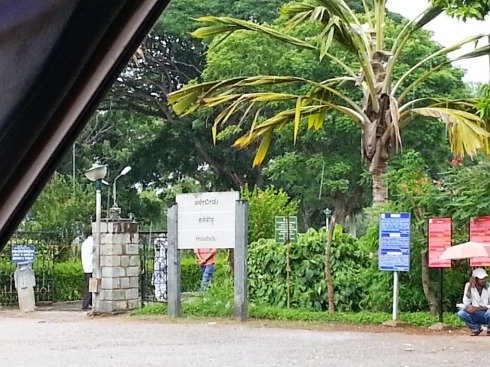
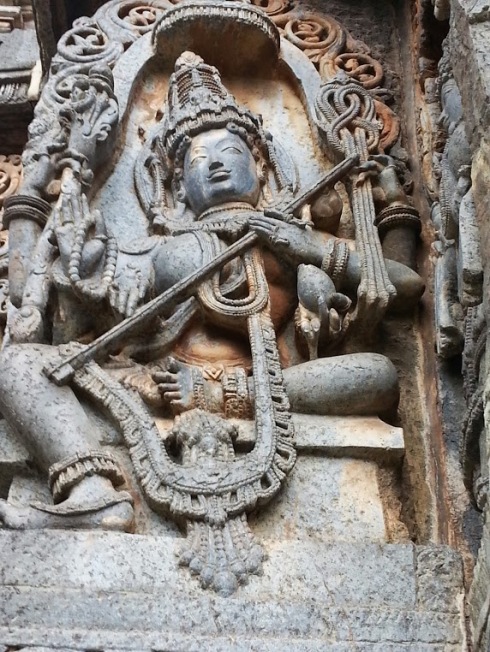
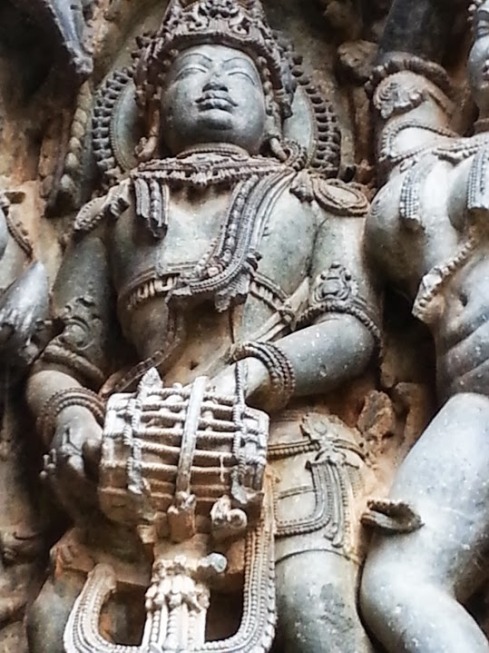
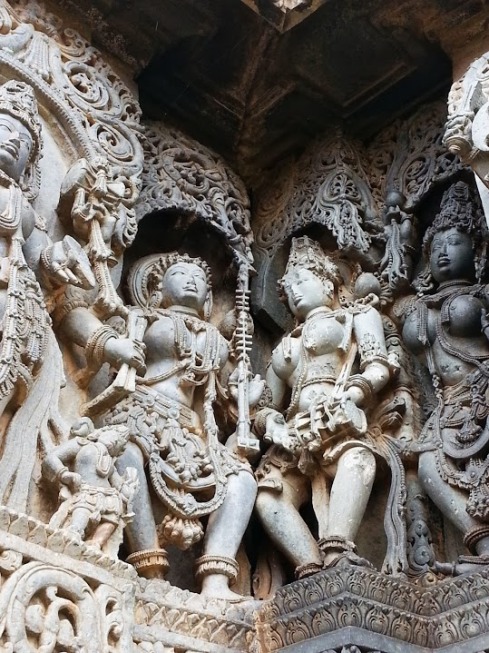
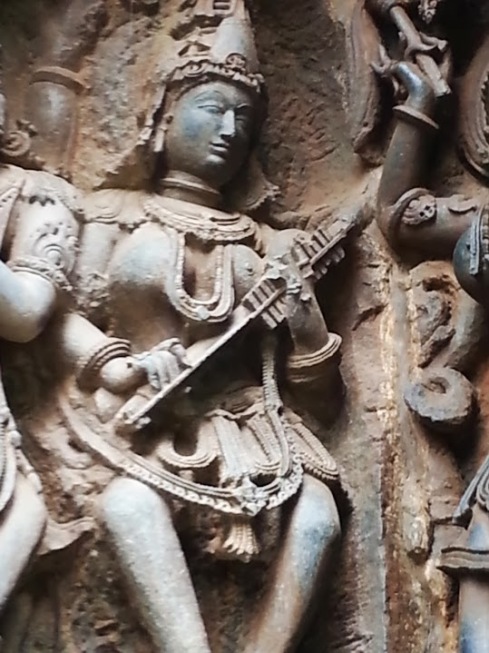
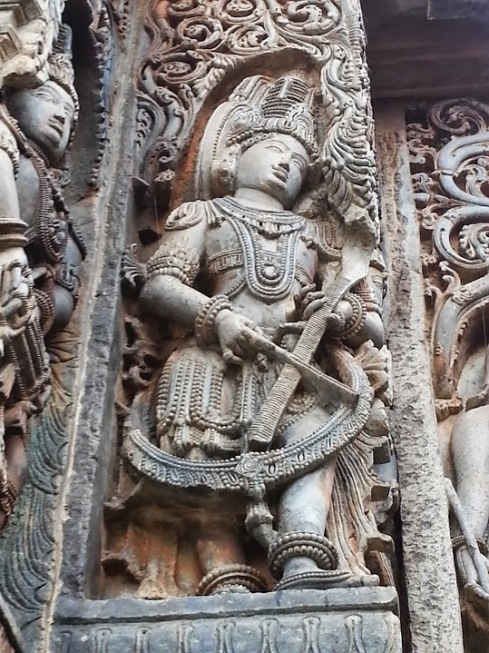
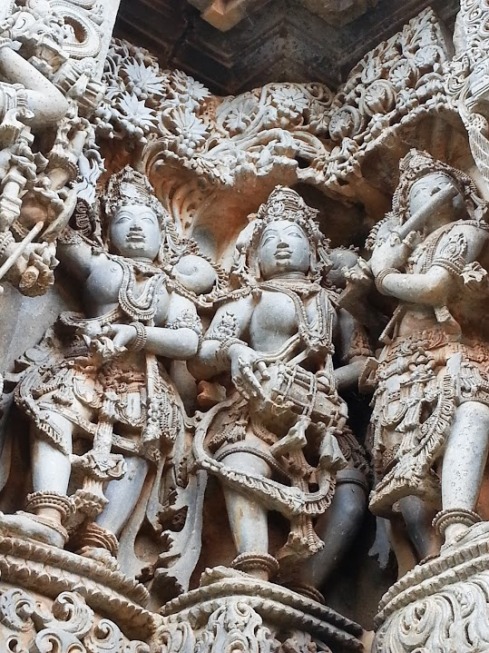


ಇತ್ತೀಚಿನ ಟಿಪ್ಪಣಿಗಳು